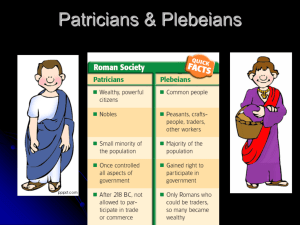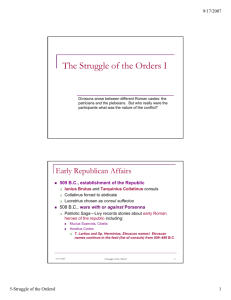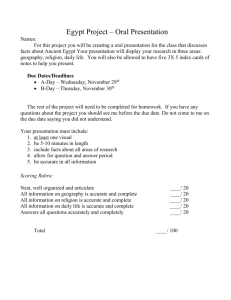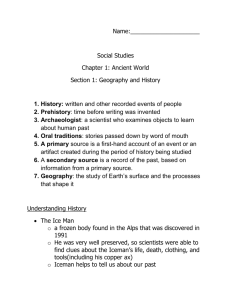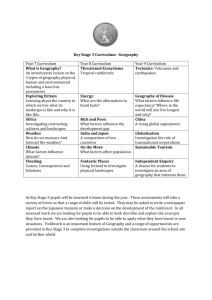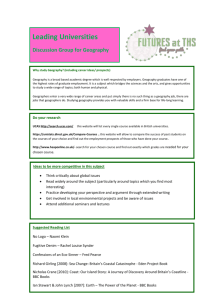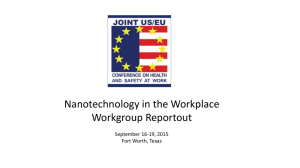Pottsgrove School District Unit Planning Organizer Subjects Social
advertisement
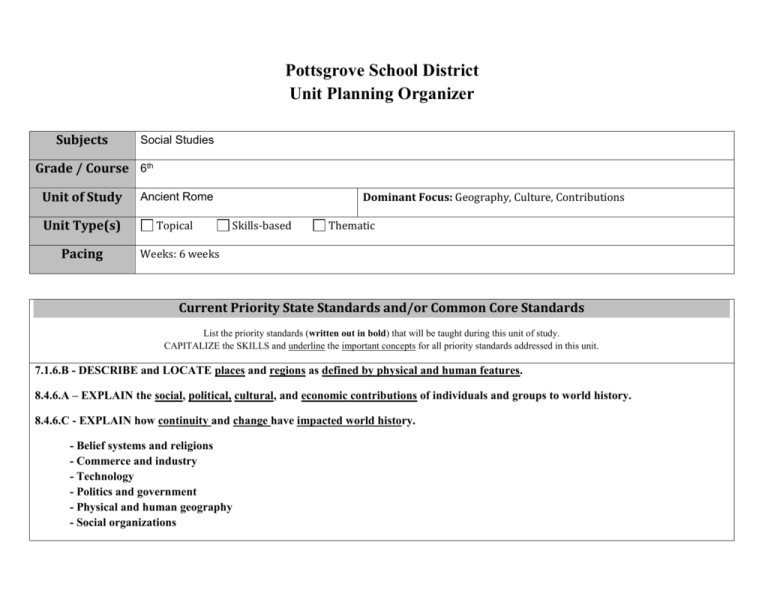
Pottsgrove School District Unit Planning Organizer Subjects Social Studies Grade / Course 6th Unit of Study Ancient Rome Unit Type(s) Topical Pacing Dominant Focus: Geography, Culture, Contributions Skills-based Thematic Weeks: 6 weeks Current Priority State Standards and/or Common Core Standards List the priority standards (written out in bold) that will be taught during this unit of study. CAPITALIZE the SKILLS and underline the important concepts for all priority standards addressed in this unit. 7.1.6.B - DESCRIBE and LOCATE places and regions as defined by physical and human features. 8.4.6.A – EXPLAIN the social, political, cultural, and economic contributions of individuals and groups to world history. 8.4.6.C - EXPLAIN how continuity and change have impacted world history. - Belief systems and religions - Commerce and industry - Technology - Politics and government - Physical and human geography - Social organizations Current Supporting State Standards and/or Common Core Standards List the supporting standards (written out in non-bold) that will be taught during this unit of study. Supporting standards should not be unwrapped. 8.4.6.B – Identify and Explain the importance of historical documents, artifacts, and sites which are critical to world history. 8.4.6.D – Compare conflict and cooperation among groups and organizations which have impacted history and development of the world. Priority Standards “Unwrapped” Concepts “Unwrapped” Skills (Students need to know) (Students need to be able to do) Ex: 8.12.U.D May also include concepts in unit but not specified in standard Ex: Verb (concept) 7.1.6.B Places and Regions as Defined by Physical Features (e.g. Apennines, Alps, Mt. Vesuvius, Tiber River, Peninsula, Seven Hills of Rome, Mild Climate) Places and Regions as Defined by Human Features (e.g. Farm land, Canals & Ports, Coliseum, Forum, Temples) 8.4.6.A 8.4.6.C Contributions of Individuals and Groups to World History (e.g. Plebeians, Patricians, Etruscans, Latins, Aeneas, Romulus, Remus, Cincinatus, Marcus, Senate, Consuls, Magistrates, Tribunes, Assembly, Tripartite, Spartacus, Hannibal) - social - political - cultural - economic Impacts of Continuity commerce & industry / technology (ECONOMIC) (e.g. ports, trade, crops) - impacts (then) - impacts (today) politics & government (POLITICAL) (e.g. Tripartite) - impacts (then) Bloom’s II Taxonomy Ex: 4 - Analyzing DESCRIBE (places and regions as defined by physical features) 2 - Understanding LOCATE (places and regions as defined by human features) EXPLAIN (social, political, cultural, and economic contributions of individuals and groups to world history) 2 - Understanding EXPLAIN (impacts of continuity) 2 - Understanding - impacts (today) physical & human geography (GEOGRAPHY) (e.g. ports, farm land, Appian Way) - impacts (then) - impacts (today) Impacts of Change belief systems & religions / social organizations (SOCIAL) (e.g. Plebeians, Patricians, Gladiators) - impacts (then) - impacts (today) politics & government (POLITICAL) (e.g. Tripartite) - impacts (then) - impacts (today) physical & human geography (GEOGRAPHY) (e.g. Cloaca Maxima – underground sewers to drain marshes between the hills) - impacts (then) - impacts (today) EXPLAIN (impacts of change) Essential Questions Essential Questions are engaging, open-ended questions that educators use to spark initial student interest in learning the content of the unit about to commence. Identify the Essential Questions that will be used throughout this unit to focus your instruction and assessment. For consideration, ask yourself the following about each essential question: 1. 2. 3. 4. Is this question written in student friendly language? Can this question be answered with one of the Big Ideas? Does the question lead the students to discovery of the Big Ideas? Does the question go beyond who, what, where, when and ask the students to explain how and why? Corresponding Big Ideas Big ideas are what you want your students to discover on their own as a result of instruction and learning activities. Identify the Big Ideas for each corresponding essential question. The goal is for students to effectively be able to respond to the teacher’s essential questions with the big ideas, stated in their 1. How did the geography of the region impact this civilization? 1. First, the fact that it was a peninsula made it easy for them to travel by sea and develop trade as well as provided protection. Second, they also had plenty of fresh water, good soil, and mild climate for farming. Third, much of the region was mountainous which provided streams, and the hills provided elevation for building cities that were protected. However, the landscape did make it difficult to travel by land. 2. How did the contributions of this civilization impact its social political, economic and/or political development? 2. Rome’s Tripartite government and written laws led to a more balanced social class system between the Patricians and Plebeians. This made the society and government more stable, otherwise there would have been upheaval by the majority group. IF TIME TO ADDRESS: The later period of the Roman Republic experienced wars because of expansion and political crises. This eventually led to the fall of the Republic. 3. How do the contributions of this civilization impact your life or society today? 3. The establishment of the Roman government provided the idea of the Republic upon which the American government was founded. In addition, the ideas of a constitution, civic duty, written set of laws, checks and balances, and the three branches all developed from the Roman model. Plan for Instruction Make connections between learning experiences and teaching strategies. Engaging Learning Experiences (Authentic Performance Tasks) Novel: Tiger Tiger Novel: Detectives in Togas Comparison/Contrast of Roman and Greek culture, government, economy Researched-based Effective Teaching Strategies graphic organizers outlines audio and video (DI) Common Assessments Note to Curriculum Designers: Review grade-or course-specific state standardized assessments for the types of questions directly related to the “unwrapped” Priority Standards' concepts and skills in focus for this unit of study. 2. Identify the vocabulary used and frequency of these questions. 3. Compare/contrast this information with the “unwrapped” concepts and skills listed above to determine how closely the two are aligned. 4. Create the Post Assessment using the Common Formative Assessment Template (Appendix A). 5. Create the Pre Assessment. Decide whether the pre-assessment will be aligned (directly matched to post-assessment but with fewer questions) or mirrored (exact number and type of questions as post-assessment. Create Informal Progress Monitoring Checks. Create short, ungraded “checks for student understanding” for the educator to administer throughout the unit of study that are directly aligned to the post-assessment questions (selected-, short-, extended-response, and/or performance-based) and that coincide with learning progressions—the “building block chunks” of instruction. 1. Post Assessment: CFA #8 Pre Assessment: CFA #8 Informal Progress Monitoring Checks: Unit Vocabulary Tier 3 Tier 2 Literary Terms Alps Plebeians peninsula Patricians temples Tiber River Republic Coliseum Senate Etruscans dictators Latins monarch Aeneas Assembly Romulus and Remus Latin Cincinatus Forum Marcus checks and balances Consuls legions Magistrates veto Tribunes Tripartite Spartacus Hannibal Instructional Resources and Materials Technology Program / Text Teacher Created
